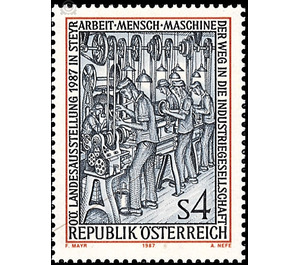Provincial exhibition - Austria / II. Republic of Austria 1987 - 4 Shilling
Theme: Art & Culture
| Country | Austria / II. Republic of Austria |
| Issue Date | 1987 |
| Face Value | 4.00 |
| Color | blue |
| Printing Type | combination printing |
| Stamp Type | Commemorative |
| Item Type | Stamp |
| Chronological Issue Number | 1223 |
| Chronological Chapter | OOS-OE2 |
| SID | 313345 |
| In 73 Wishlists | |
The Upper Austrian Provincial Exhibition titled "Work-Human-Machine, the Path to Industrial Society" took place from April to November 1987 in the "Wehrgraben", a particularly interesting part of the traditional Eisenstadt Steyr. Steyr is one of the best preserved architectural ensembles of the 16th century in Austria with its late medieval structure, which is still easily recognizable today. The iron trade and iron processing in their various forms have shaped the architecture of the city and also the subsequent development of the city in the early days. After a caesura, the economic and cultural heyday of the 15th and 16th centuries was followed by another era of economic success in the last century. The building activity in these periods still determines the overall character of the city today. The commercial tradition and the possibility of generating energy from the existing hydropower caused after 1860 the settlement of industrial companies. At that time Josef Werndl founded various small businesses, which initially served as subcontractors for his later "Austrian Arms Factory Company", which formed the outer framework for the state exhibition.


